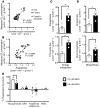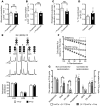Mitochondrial metabolism mediates oxidative stress and inflammation in fatty liver
- PMID: 26571396
- PMCID: PMC4665800
- DOI: 10.1172/JCI82204
Mitochondrial metabolism mediates oxidative stress and inflammation in fatty liver
Erratum in
-
Mitochondrial metabolism mediates oxidative stress and inflammation in fatty liver.J Clin Invest. 2016 Apr 1;126(4):1605. doi: 10.1172/JCI86695. Epub 2016 Apr 1. J Clin Invest. 2016. PMID: 27035816 Free PMC article. No abstract available.
Abstract
Mitochondria are critical for respiration in all tissues; however, in liver, these organelles also accommodate high-capacity anaplerotic/cataplerotic pathways that are essential to gluconeogenesis and other biosynthetic activities. During nonalcoholic fatty liver disease (NAFLD), mitochondria also produce ROS that damage hepatocytes, trigger inflammation, and contribute to insulin resistance. Here, we provide several lines of evidence indicating that induction of biosynthesis through hepatic anaplerotic/cataplerotic pathways is energetically backed by elevated oxidative metabolism and hence contributes to oxidative stress and inflammation during NAFLD. First, in murine livers, elevation of fatty acid delivery not only induced oxidative metabolism, but also amplified anaplerosis/cataplerosis and caused a proportional rise in oxidative stress and inflammation. Second, loss of anaplerosis/cataplerosis via genetic knockdown of phosphoenolpyruvate carboxykinase 1 (Pck1) prevented fatty acid-induced rise in oxidative flux, oxidative stress, and inflammation. Flux appeared to be regulated by redox state, energy charge, and metabolite concentration, which may also amplify antioxidant pathways. Third, preventing elevated oxidative metabolism with metformin also normalized hepatic anaplerosis/cataplerosis and reduced markers of inflammation. Finally, independent histological grades in human NAFLD biopsies were proportional to oxidative flux. Thus, hepatic oxidative stress and inflammation are associated with elevated oxidative metabolism during an obesogenic diet, and this link may be provoked by increased work through anabolic pathways.
Figures








References
-
- Beylot M, Soloviev MV, David F, Landau BR, Brunengraber H. Tracing hepatic gluconeogenesis relative to citric acid cycle activity in vitro and in vivo. Comparisons in the use of [3-13C]lactate, [2-13C]acetate, and α-keto[3-13C]isocaproate. J Biol Chem. 1995;270(4):1509–1514. doi: 10.1074/jbc.270.4.1509. - DOI - PubMed
-
- Walter P, Paetkau V, Lardy HA. Paths of carbon in gluconeogenesis and lipogenesis. 3. The role and regulation of mitochondrial processes involved in supplying precursors of phosphoenolpyruvate. J Biol Chem. 1966;241(11):2523–2532. - PubMed
Publication types
MeSH terms
Substances
Grants and funding
- UL1 TR001105/TR/NCATS NIH HHS/United States
- P01DK058398/DK/NIDDK NIH HHS/United States
- R01 DK078184/DK/NIDDK NIH HHS/United States
- NIH RO1DK078184/DK/NIDDK NIH HHS/United States
- P01 DK058398/DK/NIDDK NIH HHS/United States
- P41 EB015908/EB/NIBIB NIH HHS/United States
- RL1DK081187/DK/NIDDK NIH HHS/United States
- UL1 TR001427/TR/NCATS NIH HHS/United States
- UL1 RR024982/RR/NCRR NIH HHS/United States
- R01 DK087977/DK/NIDDK NIH HHS/United States
- UL1 DE019584/DE/NIDCR NIH HHS/United States
- RL1 DK081187/DK/NIDDK NIH HHS/United States
- UL1-RR024982/RR/NCRR NIH HHS/United States
- DK087977/DK/NIDDK NIH HHS/United States
- UL1DE019584/DE/NIDCR NIH HHS/United States
LinkOut - more resources
Full Text Sources
Other Literature Sources
Medical
Molecular Biology Databases

